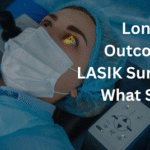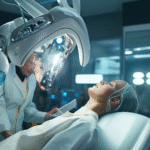Table of Contents
- Understanding Night Vision Challenges After Laser Eye Surgery
- What Is Custom LASIK?
- What Is Contoura Vision Surgery?
- Custom LASIK vs Contoura Vision: How Each Affects Night Vision Quality
- Patient Suitability for Custom LASIK vs Contoura Vision Surgery
- Conclusion
- Frequently Asked Questions
LASIK surgery has become the most common treatment option for getting rid of glasses and contact lenses. While its high success rate has made it the most sought-after treatment for eye patients, there have been growing concerns regarding its impact on night vision. In this article, we will examine how patients can choose the latest advanced treatment options for treating common eye ailments.
Understanding Night Vision Challenges After Laser Eye Surgery
Some of the common night vision complaints patients make after laser eye surgery are frequent occurrences of halos, glare, starbursts, or difficulty seeing clearly in low-light conditions.
These symptoms tend to get worse if the patients also suffer from corneal irregularities. To reduce the frequency of these common eye issues and smooth the corneal surface, medical experts are realizing the importance of personalized treatment options such as Custom LASIK surgery and Contoura Vision surgery.
What Is Custom LASIK?
It is a common phenomenon where patients are prescribed the same eyeglasses even though their eyeglass prescriptions are different. This often leads to worsening of the symptoms the patient is experiencing. In such cases, doctors recommend Custom Wavefront LASIK or Custom LASIK surgery.
Custom Wavefront LASIK or Custom LASIK surgery is the most advanced laser technology available to correct eye problems with utmost precision. With the help of a specialized laser known as wavefront-guided technology, doctors measure the eye from front to back to create a three-dimensional image of the eye. Furthermore, they can also create detailed, unique features for each person’s eyes that cannot be otherwise measured with the traditional techniques.
By applying advanced wavefront technology, doctors can map any internal aberration inside the eye with accuracy and personalization. Hence, it can lower irregular, higher-order aberrations, which contribute to decreased visual clarity.
Unlike traditional LASIK surgery techniques, which employ a one-size-fits-all approach, Custom LASIK focuses on using precise eye measurements to ensure better outcomes, including lower chances of halos and glare.
What Is Contoura Vision Surgery?
Another groundbreaking innovative technique for correcting vision is the Contoura Vision surgery. This technique allows patients to correct their vision for a lifetime. The highlight of this procedure is that it uses a unique technique known as topography-guided mapping that creates a 3D map of the eyes, capturing even the most minute irregularities.
Also known as Topography-guided LASIK surgery, he topography-guided mapping allows eye doctors to map out the anatomy of the eye by 22000 points on the cornea. Unlike Custom LASIK surgery, this procedure takes into account the irregularities of the eye’s surface.
Hence, this procedure customizes correcting surface imperfections of the cornea as well as refractive errors, which in turn improves both the clarity and quality of the vision.
The reason this technique has become so popular in recent times is that it is mostly non-invasive. There are no blades, stitches, or injections used during the procedure.
Custom LASIK vs Contoura Vision: How Each Affects Night Vision Quality
The primary issue of curing night vision with traditional LASIK surgery is that it causes post-operative symptoms that can cause discomfort to patients. Hence, medical experts are recommending that patients opt for more advanced procedures such as Custom LASIK and Contoura Vision. Let’s have a look at how these procedures improve night vision quality.
As explained earlier, custom LASIK improves night vision by correcting common refractive errors and subtle cornea abnormalities with the help of wavefront technology. It creates a detailed anatomy of the eye that allows doctors to cure the issue and associated symptoms, such as the occurrence of glare and halos, which are common complaints after traditional LASIK.
Additionally, it smoothens the corneal surface, which allows clearer and sharper vision even in low-light conditions. However, according to some medical studies, the challenge with this technique is that it is limited to curing only particular corneal aberrations.
Similar to custom LASIK, the contoura vision surgery also improves night vision by mapping and reshaping the cornea to correct irregularities that cause glare, halos, and blurred vision in low light. But there is a significant difference between the two techniques.
As compared to custom LASIK, Contoura vision surgery smoothens a greater corneal surface, thereby providing sharper and clearer vision at night. The latter enables patients to distinguish between subtle variations in light and color, which is vital for night vision.
| Custom LASIK Surgery | Contoura Vision Surgery |
| Includes using a limited number of points (around 200) to map the cornea | Includes using a topography-guided mapping to create a detailed 3D map of the cornea, analyzing around 22,000 points |
| Corrects refractive errors | Corrects refractive errors and corneal irregularities |
| Aims to achieve 20/20 vision | Some studies suggest that patients achieve vision better than 20/16 |
| Experts use a femtosecond laser | Experts use a combination of lasers (like Femto, Excimer, and Topolyser) |
| Cures nearsightedness, farsightedness, and astigmatism | Cures higher-order aberrations (imperfections not corrected by glasses or contacts |
Patient Suitability for Custom LASIK vs Contoura Vision Surgery
A common question that doctors come across from patients is which procedure will cure their problem permanently.
There are a lot of factors that doctors take into account while prescribing the appropriate treatment option. Some of these include:
- Corneal topography
- Pupil size
- Vision stability considerations
Although both these procedures are generally prescribed to correct refractive errors and corneal irregularities, it is important to note that patients should consider a thorough pre-operative evaluation and seek expertise before undergoing the procedure.
Conclusion
To sum it up, both Custom LASIK and Contoura vision surgeries are advanced treatment options to cure refractive errors and corneal abnormalities. However, some studies confirm that the latter may provide improved night vision in select patients as it involves a much personalized approach. Choosing between the two procedures is a difficult decision. Thus, it is advised that the final call should be based on the doctor’s suggestions combined with personalized eye tests.





